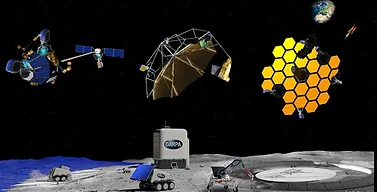Strasbourg, France, 12 February 2021 – As commercial space companies increase the cadence of successful rocket launches, access to space is becoming more routine for both government and commercial interests. But even with regular launches, modern rockets impose mass and volume limits on the payloads they deliver to orbit. This size constraint hinders developing and deploying large-scale, dynamic space systems that can adapt to changes in their environment or mission.
To address this problem, DARPA today announced its Novel Orbital and Moon Manufacturing, Materials and Mass-efficient Design (NOM4D) program. The effort, pronounced “NOMAD,” seeks to pioneer technologies for adaptive, off-earth manufacturing to produce large space and lunar structures. A Proposers Day webinar for interested proposers is schedule for February 26, 2021.
“NOM4D’s vision is to develop foundational materials, processes, and designs needed to realize in-space manufacturing of large, precise, and resilient Defense Department systems,” said Bill Carter, program manager in DARPA’s Defense Sciences Office. “We will explore the unique advantages afforded by on-orbit manufacturing using advanced materials ferried from Earth. As an example, once we eliminate the need to survive launch, large structures such as antennas and solar panels can be substantially more weight efficient, and potentially much more precise. We will also explore the unique features of in-situ resources obtained from the moon’s surface as they apply to future defense missions. Manufacturing off-earth maximizes mass efficiency and at the same time could serve to enhance stability, agility, and adaptability for a variety of space systems.”
The NOM4D program will pioneer new materials and manufacturing technologies for construction on orbit and on the lunar surface as well as explore new mass-efficient designs.
“People have been thinking about on-orbit manufacturing for some time, so we expect to demonstrate new materials and manufacturing technologies by the program’s end,” Carter said. “The lunar-surface focus area will be geared more towards trade studies and targeted demonstrations.”
Concerning mass-efficient designs, the vision is for completely new concepts that could only be manufactured in space.
“We’re looking for proposers to come up with system designs that are so mass-efficient that they can only be built off-earth, and with features that enable them to withstand maneuvers, eclipses, damage, and thermal cycles typical of space and lunar environments,” Carter said. “Given the constraints of ground test, launch and deployment, the traditional approach to designing space structures is not likely to result in dramatic improvements in mass efficiency. In order to take the next step, we’ve got to go about materials, manufacturing, and design in a completely new way.”
The program is divided into three 18-month phases that build towards the ability to create incredibly precise, mass efficient structures from feedstock. Each phase is driven by metrics derived from increasingly challenging exemplar problems. Phase I is considered the proof of concept for materials and designs that meet stringent structural efficiency targets using the exemplar problem of a 1-megawatt solar array. Phase II focuses on risk reduction and technical maturation of the technology to meet structural targets, while maintaining high precision sufficient to meet the requirements of an exemplar 100m diameter RF reflector. Phase III drives a substantial leap in precision to enable IR reflective structures suitable for use in a segmented long-wave infrared telescope. The exemplars are designed to drive metrics for each phase, and ground-based fabrication of sub-scale exemplar structures (as opposed to the full structures) will be fabricated as part of the program to validate advanced NOM4D material, manufacturing and design capabilities.
NOM4D assumes an established space ecosphere by 2030 comprising reliable logistics, facilities, and validation. This includes rapid, frequent launch with regularly scheduled lunar visits; mature robotic manipulation tools for building structures in space and routine on-orbit refueling of robotic servicing spacecraft (e.g. DARPA’s Robotic Servicing of Geosynchronous Satellites program technologies); and the availability of in-space, non-destructive evaluation methods for in-process monitoring of manufacturing and near real-time design adjustments.















